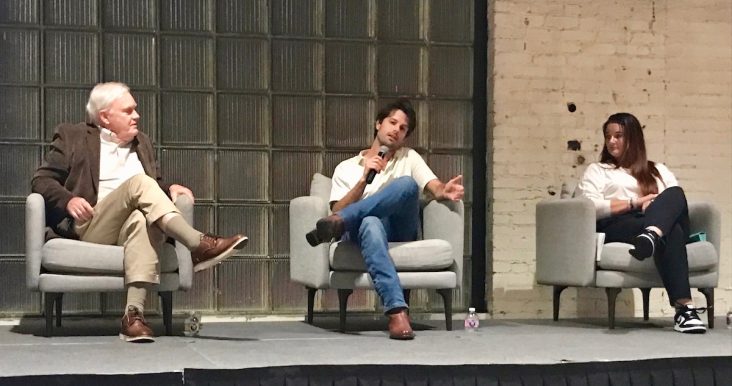Panelists: ’Walkability,’ residential living, better connections key to downtown Fort Smith growth
by November 10, 2023 10:20 am 1,159 views

(from left) Bennie Westphal, Sam Hanna and Ashleigh Bachert participated Thursday (Nov. 9) in a discussion about opportunities and challenges in downtown Fort Smith.
Downtown Fort Smith has “incredible bones,” and a corporate headquarters building in the area would build on recent momentum. But business and civic leaders need to do all they can to ensure the downtown is not perceived by tourists as an “old West sleeper town.”
Those were some of the opinions expressed during a Thursday night (Nov. 9) panel discussion on the good and not-so-good about downtown Fort Smith. The “Downtown Dialogues” was hosted by Prime and held in the Bakery District downtown. Prime is a nonprofit focused on “engaging the Fort Smith community by championing economic development and creating opportunities for professionals” in the region.
Fort Smith Mayor George McGill was the moderator, and the panelists were:
• Ashleigh Bachert, executive director of the Fort Smith Convention & Visitors Bureau;
• Sam Hanna, steering committee member of the Community Mobility Plan, and part of a family business redeveloping property in downtown Fort Smith;
• Maggie Rice, director of Planning & Zoning with the City of Fort Smith; and
• Bennie Westphal, Fort Smith business and community leader whose family owns downtown property, including land along the Arkansas River.
When asked about key milestones in downtown Fort Smith, Westphal said the creation in the 1970s of the Central Business Improvement District began a focus on improving the area. He also reminded the audience that city residents voted in a special tax to “turn your scars into stars” following the 1996 tornado that destroyed many downtown buildings. That limited sales tax expanded the convention center, renovated the riverfront, including Harry E. Kelley Park improvements, and significantly expanded the library system.
“That [tornado destruction] forced the city to step up and people in the community to step up,” Westphal said. (Westphal is an investor in Natural State Media, the parent company of Talk Business & Politics.)
Hanna praised The Unexpected Project for “having quite a large effect” on the downtown and changing attitudes among business and city leaders about the downtown. The Unexpected was founded in 2015 by Fort Smith businessman Steve Clark to bring art – often with large murals on the sides of buildings – to downtown Fort Smith. Bachert also praised The Unexpected and added that the opening of the U.S. Marshals Museum is a milestone for the city. She stressed that business and city officials continue to ensure that the riverfront area is inviting and “open for development.”
Rice said beginning in 2014, the city adopted new downtown development codes intended to promote diverse development in the area. She said the city’s 2012 Comprehensive Plan also directed city officials to do more to support the downtown.
“There was a real focus on the downtown that came out of that,” Rice said, adding that a “form-based code” is now a “completely new idea” in how the city hopes to help downtown development.
Westphal said, based on his assessment of other communities, especially Frisco, Texas, that the three keys to growth in a downtown area are entertainment, sports and cultural events. He said residential spaces in downtown Fort Smith are also needed.
“We just need more people living downtown. … You’re going to get more entertainment, more retail … especially with young people coming downtown,” he said.
Westphal said later in the discussion that “if you dream big,” landing a company that would build its corporate headquarters downtown would provide a big boost in bringing more residential development to the area.
Hanna, who said the downtown has “incredible bones” that support development, said a top challenge to making the area more walkable and hospitable to downtown residents and visitors is that Garrison Avenue – the main road through the downtown – is a state highway used by large trucks.
“It’s got to be one of the worst things to happen to this city,” Hanna said of Garrison being a main thoroughfare. He said the avenue needs to be turned into a city street and “redesigned for multi-modality” use.
Bachert added to that, saying the downtown “has to have vibrancy” that appeals to tourists. Heavy traffic and shops that close early do not encourage visitors. She said the city is competing with cities that have more welcoming downtowns.
“We’re going to get passed by on a lot of things (conventions, events, etc.) because they will stereotype us as that old West sleeper town,” she said about making the area more inviting to a wider range of people.
Following are other comments from the panelists.
• Hanna said making people feel safe when walking and bicycling in the downtown is a key to improving walkability.
“Walkability is vital to the heart and soul of downtown, the heart and soul of the city,” he said.
• Rice said “activation of the riverfront” was a focus when she began working with the city 17 years ago and continues to be a focus. She said part of that focus is finding ways to better connect the downtown with nearby residential areas.
• Westphal received applause from the audience when saying his goal is to see a multi-use sports stadium built on the riverfront, with possibly a high-rise hotel next to it.
